
Exposure to illegal labour markets in childhood leads to the formation of industry-specific human capital, putting children on a criminal life path
Illegal markets and the associated crime are critical concerns in developing countries and in marginalised areas of rich countries. While criminal leaders such as Al Capone, Pablo Escobar and El Chapo draw a lot of attention, illegal markets operate thorough a much larger set of individuals who support these organizations. Yet, we know far less about how these individuals enter crime. Are these decisions simply a spot benefit-cost calculus or are there specific and persistent factors that lead people to enter a life of crime from an early age?
I find evidence that exposure to illegal labour markets during childhood leads to the formation of industry-specific human capital at an early age, putting children on a criminal life path in the cocaine industry (Sviatschi 2019). There are three main results.
- First, using exogenous shocks to illegal labour markets in Peru, I show that when the return to illegal activities increases in areas suitable for coca production, parents significantly increase the use of child labour for coca farming.
- Second, I find that this response in turn increases children’s criminal capital and the chances that they remain in the cocaine industry. As adults, affected children are 30% more likely to be incarcerated for violent and drug-related crimes, and have lower earnings.
- Third, I show that policies that target the incentives surrounding these early investments can mitigate the effects of exposure to illegal labour markets by half. In particular, I show that conditional cash transfers that encourage schooling can reduce child labour in the illegal sector, and thus, drug production in coca suitable areas.
From Colombia to Peru
To establish these results, I take advantage of drug enforcement policies in Colombia that shifted coca leaf production to Peru, where 90% of coca production is used to produce cocaine. In particular, in 1999, Colombia, then the world’s largest cocaine producer, implemented Plan Colombia, a US-supported military-based interdiction intervention. One of the main components was the aerial spraying of coca crops in Colombia. This intervention resulted in higher prices and expanded coca production in Peru, where production doubled in districts with the optimal agro-ecological conditions. By 2012, Peru had become the largest producer of cocaine in the world (shown in Figure 1). This setting yields three useful sources of variation: i) geographic variation in coca-growing in Peru, ii) over-time variation in coca prices induced by Colombian shocks, and iii) variation in the age of exposure.
Figure 1 Coca production in the Andean region
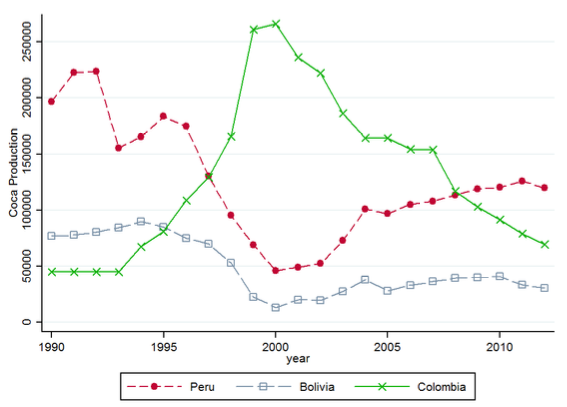
How criminal careers can be the result of exposure to illegal labour markets during childhood
Short-run effect: Responses on child labour and schooling
Investments in children’s human capital are negatively affected by the cocaine industry during the period 1994-2013, as shown in Figure 2. For example, the 70% increase in coca prices induced by Colombia’s anti-drug policy over 1997 to 2003 leads to a 30% increase in child labour in areas suitable for coca production. Children between the ages of six and 14 are most affected relative to older children, with the largest effects for those in their early teens. In addition, the relatively high earnings in the cocaine industry induce some secondary school-aged children to drop out of school. Furthermore, I find that these results are not driven by violence, conflict, or migration.
Figure 2 Child labour in coca and non-coca districts in Peru versus coca production in Colombia
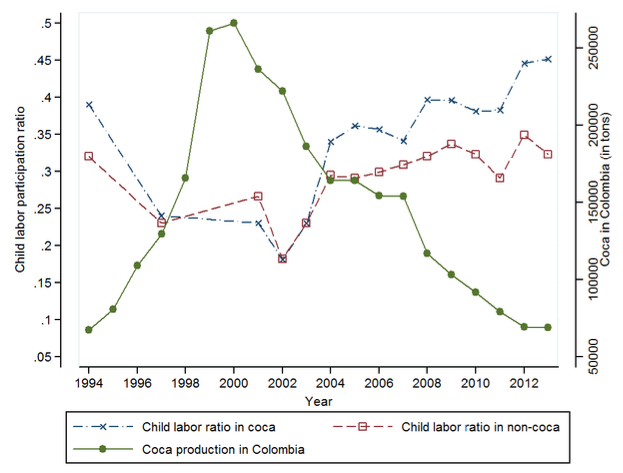
Long-run effect: More likely to be incarcerated
I then ask how childhood exposure to illegal labour markets affects children’s long-run outcomes at the ages of 18 to 30. I find that individuals who grew up in coca producing areas and experienced high coca prices during childhood are about 30% more likely to be incarcerated than their counterparts. The effects are concentrated among children who experienced high coca prices in their early teens (depicted in Figure 3), the ages when child labour in the cocaine industry increases the most.
Figure 3 Incarceration rate effect by age.
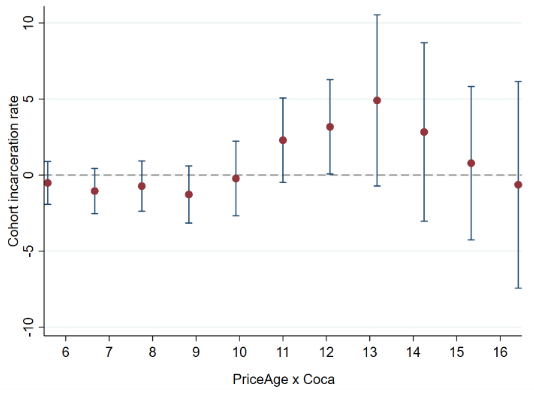
Mechanisms driving criminal careers
There are two potential mechanisms underlying the link between childhood participation in coca farming and future criminality: a decline in general human capital, and an increase in industry-specific human capital. First, exposed children have lower formal education and this deficiency can lead to criminality. Second, individuals may acquire skills specific to the illegal sector such as knowledge about transforming coca into cocaine and smuggling, and social capital specific to the illegal industry such as connections to buyers.
I report three sets of results suggesting that the increase in adult criminality is mainly driven by the acquisition of human capital that is specific to the illegal industry. First, children who end up growing coca as a result of the price shocks are more likely to be convicted of violent and drug-related crimes in the future, but not of other types of crimes such as property crime or white collar crime. Second, price shocks to legal commodities that also increased child labour, do not have an effect on the likelihood of future criminality. Moreover, individuals from districts where most coca is grown for traditional medical and religious purposes are not involved in crime later in life, even though they worked during childhood. Third, these negative effects of childhood involvement in coca growing are found not only for those who remain in coca growing districts as adults, but also for those who move to districts without coca production. This finding implies that the long-term effects are not caused by contemporaneous exposure to the cocaine industry during adulthood but rather to exposure during childhood. In addition, the overwhelming majority of individuals who are estimated to be in prison due to the price shock report that they were involved in illegal activities before the age of 18 and reported farming as their last occupation, indicating that they likely started their criminal career growing coca, leading to an increase in their criminal capital
How policy can address these mechanisms via geographic targeting of incentives
Having shown that criminal careers can develop during childhood, I then ask whether changing parental incentives in the affected areas can mitigate the negative effects of the cocaine industry. I exploit the gradual rollout of a conditional cash transfer programme (CCT) during the period of high coca prices. The programme provided monetary transfers to parents with the condition that children attended school on a daily basis. The programme targeted younger children between the ages of 6 and 14 and was not intended to reduce drug production.
Consistent with the hypothesis that parental responses during childhood matter, I show that coca areas that implemented the programme experienced a significant reduction in both coca production and child labour, as shown in Figure 4. These results suggest that CCTs can be potentially targeted toward coca suitable districts in order to mitigate the effects of high coca prices. Moreover, even if there is substitution into adult labour, adults working in coca farms are less likely to engage in other stages of production and to start a criminal career in the industry.
Figure 4 The effect of CCTs when coca prices are high
(a) Child labour relative to years with CCT
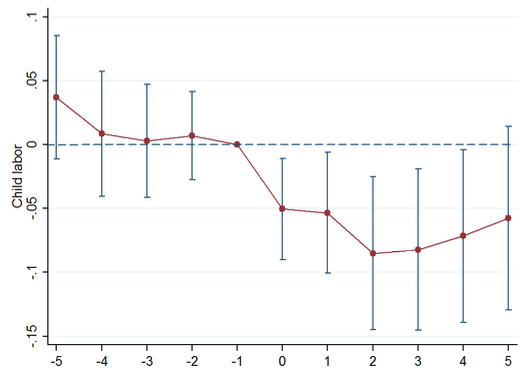
(b) Coca production relative to years with CCT
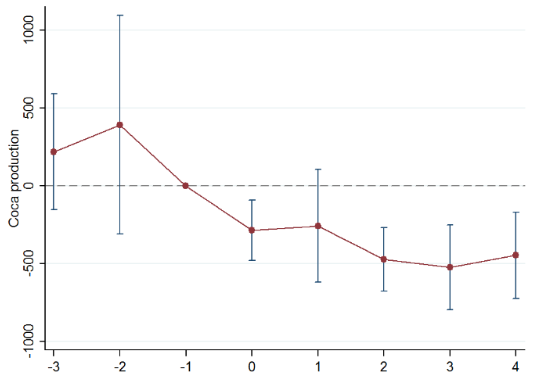
Policy implications: A potentially more cost-effective way to reduce coca production than enforcement alone
The formation of criminal human capital early in life can explain adult occupational choices and the perpetuation of illegal industries. By finding one potential cause of future criminality, I help to understand what policies can limit the formation of illegal markets and associated crime. Most of the previous literature and policy has focused on traditional deterrence methods in developed countries. However, in the context of developing countries, increased policing and incarceration may be particularly problematic given issues related to corruption, the limited capacity of the judicial system, and overcrowding of prisons.1 In my paper, since effects are driven by exposure during childhood, I show that policies that target incentives for child labour reduce the development of criminal careers and can potentially be a more cost effective way to reduce coca production than enforcement alone.
References
Abadie, A, M Acevedo, M Kugler and J Vargas (2015), “Inside the war on drugs: Effectiveness and unintended consequences of a large illicit crops eradication program in Colombia.”
Castillo, J, D Mejia and P Restrepo (2014), “Scarcity without leviathan: The violent effects of cocaine supply shortages in the mexican drug war”, Available at SSRN 2409268.
Dell, M (2015), “Trafficking networks and the Mexican drug war”, The American Economic Review, 105(6): 1738–1779.
Heckman, J (2006), “Skill formation and the economics of investing in disadvantaged children”, Science, 312(5782): 1900– 1902.
Miron, J (1999), “Violence and the US prohibitions of drugs and alcohol”, American Law and Economics Review, Fall(1- 2): 78–114.
Sviatschi, M M (2019), “Making a Narco: Childhood Exposure to Illegal Labor Markets and Criminal Life Paths”, working paper.
Werb, D, G Rowell, G Guyatt, T Kerr, J Montaner and E Wood (2011), “Effect of drug law enforcement on drug market violence: A systematic review”, International Journal of Drug Policy, 22(2): 87–94.
Endnotes
[1] Moreover, previous literature has shown how drug enforcement measures can often lead to increased violence or further displace crime. Dell (2015) shows how drug enforcement caused a large increase in homicide rates in Mexico. Also, Abadie et al. (2014) finds that aerial eradication exacerbated armed conflict and violence in Colombia, by reducing guerrillas’ main source of income. Castillo et al. (2014) show how changes in drug enforcement in Colombia generated an increase in violence in Mexico. For a review on drug enforcement measures and violence see Werb et al. (2011) and Miron (1999), which document a positive relationship.

